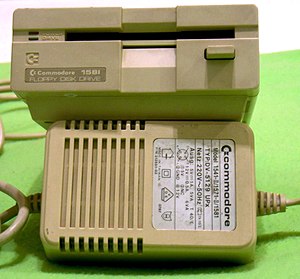Commodore 1581

Commodore 1581
|
|
| Manufacturer | Commodore Business Machines, Inc. |
|---|---|
| Type | Floppy drive |
| Release date | 1987 |
| Introductory price | USD 399 (1987) USD 800 (2017 equivalent) |
| Discontinued | 1990 |
| Media | 3½" floppy disk DSDD using MFM |
| Operating system | CBM DOS 10.0 |
| CPU | MOS 6502 @ 2 MHz, WD1770 or WD1772 |
| Memory | 8 kB RAM 32 kB ROM |
| Storage | 800 kB |
| Connectivity | Commodore proprietary serial IEEE-488 burst mode 9000 bytes/s |
| Power | 220 V 50 Hz 10 W |
| Dimensions | 63 x 140 x 230 |
| Weight | 1.4 kg |
| Backward compatibility |
Commodore 64 |
The Commodore 1581 is a 3½-inch double-sided double-density floppy disk drive that was released by Commodore Business Machines (CBM) in 1987, primarily for its C64 and C128 home/personal computers. The drive stores 800 kilobytes using an MFM encoding but format different from MS-DOS (720 kB), Amiga (880 kB), and Mac Plus (800 kB) formats. With special software it's possible to read C1581 disks on an x86 PC system, and likewise, read MS-DOS and other formats of disks in the C1581 (using Big Blue Reader), provided that the PC or other floppy handles the "720 kB" size format. This capability was most frequently used to read MS-DOS disks. The drive was released in the summer of 1987 and quickly became popular with bulletin board system (BBS) operators and other users.
Like the 1541 and 1571, the 1581 has an onboard MOS Technology 6502 CPU with its own ROM and RAM, and uses a serial version of the IEEE-488 interface. Inexplicably, the drive's ROM contains commands for parallel use, although no parallel interface was available. Unlike the 1571, which is nearly 100% backward-compatible with the 1541, the 1581 is only compatible with previous Commodore drives at the DOS level and cannot utilize software that performs low-level disk access (as the vast majority of Commodore 64 games do).
The version of Commodore DOS built into the 1581 added support for partitions, which could also function as fixed-allocation subdirectories. PC-style subdirectories were rejected as being too difficult to work with in terms of block availability maps, then still much in vogue, and which for some time had been the traditional way of inquiring into block availability. The 1581 supports the C128's burst mode for fast disk access, but not when connected to an older Commodore machine like the Commodore 64. The 1581 provides a total of 3160 blocks free when formatted (a block being equal to 256 bytes). The number of permitted directory entries was also increased, to 296 entries. With a storage capacity of 800 kB, the 1581 is the highest-capacity serial-bus drive that was ever made by Commodore (the 1-MB SFD-1001 uses the parallel IEEE-488), and the only 3½" one. However, starting in 1991, Creative Micro Designs (CMD) made the FD-2000 high density (1.6 MB) and FD-4000 extended density (3.2 MB) 3½" drives, both of which offered not only a 1581-emulation mode but also 1541- and 1571-compatibility modes.
...
Wikipedia
